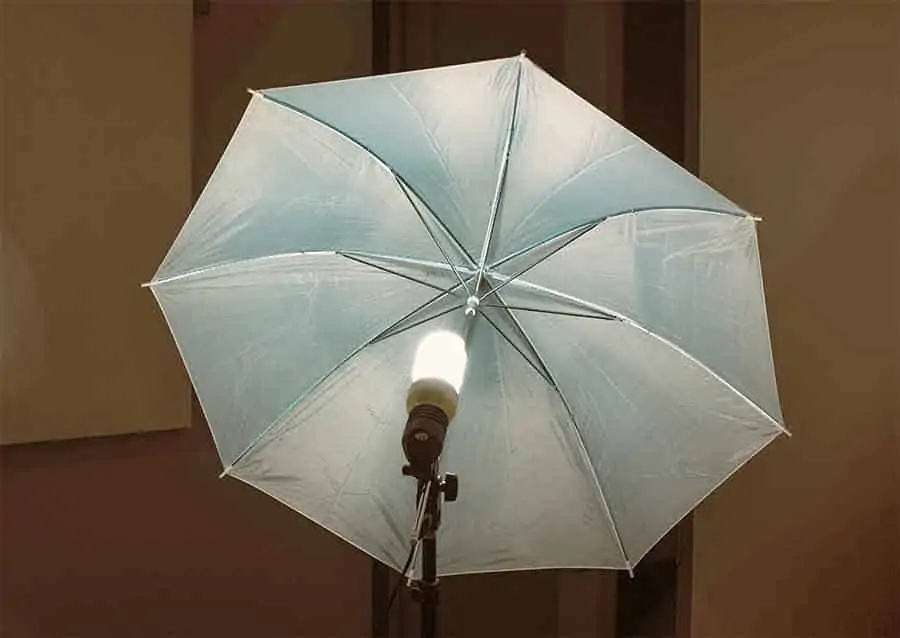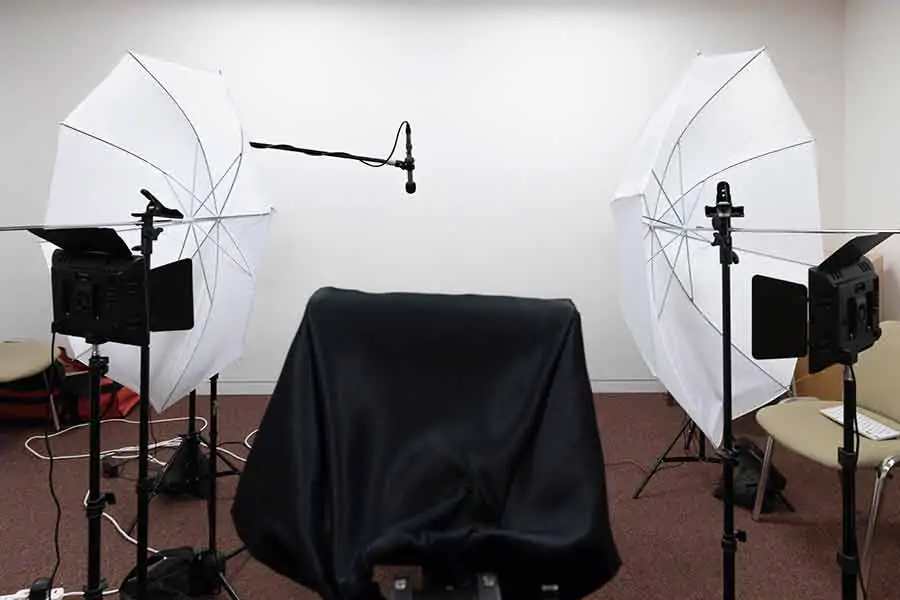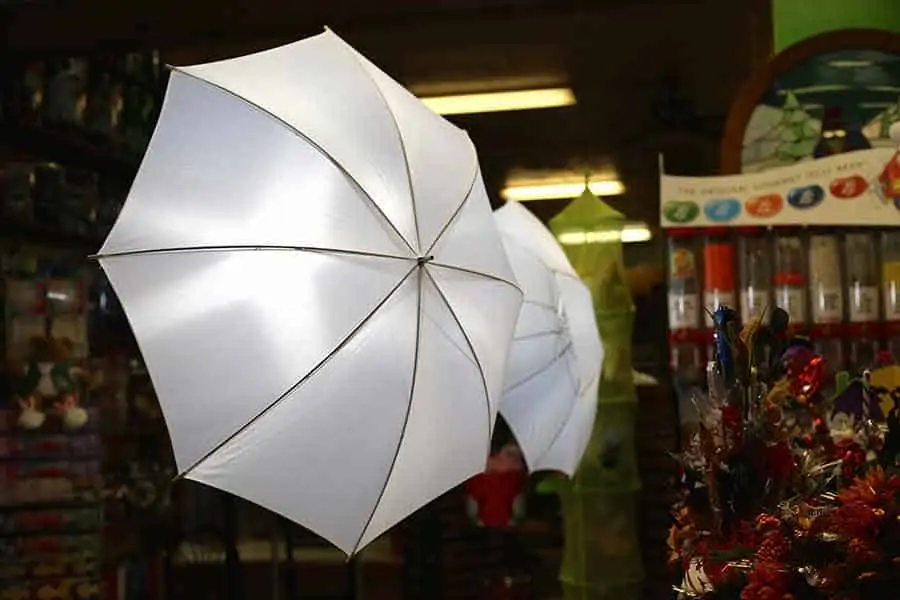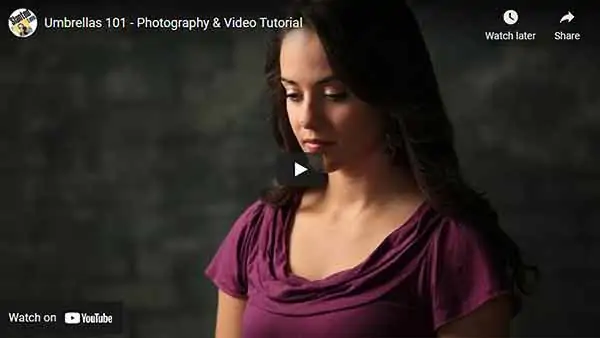DIY Video Studio is supported by its readers. Please assume links on this site are affiliate links or ads, and that I get commissions for purchases made through these links. As an Amazon Associate, I earn from qualifying purchases. Thank you if you use any of the links.
Today I’m considering the types of photography umbrellas that can be used for both photography and videography. In fact. This was the type of lighting I used when I started my successful video production business about 10 years ago.
There are basically four types of photography Umbrellas, although they can also be used for video production. They are a) the Shoot Though Umbrella; b) the Reflective Umbrella; c) the Parabolic Umbrella, and d) the Umbrella Softbox.
The great attraction of this type of light modifier for my new business was that they took up little space (therefore easy to transport), they were cheap, they only took a few minutes, and I could use them for both photography and videography.
There are four distinct types of photography umbrellas: shoot-through, reflective, Parabolic, and umbrella softbox. All of them can produce a soft quality of light that helps flatter and make the subject look great. However, there are significant differences.
If you are unsure what a photography umbrella or umbrella light is, check out the next section, “What is an umbrella light“.
To dive straight into the four types of photography umbrellas you will typically find available online, click on the following links.
What is an umbrella light?

As the name suggests, these light modifiers look like umbrellas, but without a handle.
They have a central metal column and several flexible rods that effectively stretch the covering material into 8 or more curved triangle-shaped panels. The material is either a white diffusing fabric or an opaque black fabric that is reflective on the inside.
The technology is simple. The purpose is to change the quality of your light by spreading it across a larger area, effectively broadening the light source.
Umbrella Size Matters
Photography umbrellas are available in many sizes. Typically, the smallest will be 33-inches. The largest being around 7-feet in diameter.
As you increase the size of the umbrella the shadows will seem to soften.
The smaller the umbrella (relative to the subject) the harder the light. The larger the umbrella the softer the light.
The distance of the umbrella from the subject is also a factor.
Reduce the umbrella-to-subject distance for a softer light and increase the distance for a harder light.
Which way round do umbrella lights face?
No matter what type of photography umbrella you use, the bulb or lamp always points inwards, towards the umbrella fabric.
Now that you know which way the bulb points, you probably want to know which part of the umbrella faces your subject? The answer depends on the type of umbrella you are using. I’ll answer the question in the section for each type of umbrella.
Jay P Morgan from The Slanted Lens YouTube channel presents a highly informative video on umbrella lights. Although the setups are for photography, the tutorial provides a lot of useful information for the videographer.
Shoot Through umbrella lights

The shoot-through umbrella is the first of the four types of photography umbrellas I will mention.
The light or bulb point into the umbrella. The intention is to illuminate all the white diffuser material. Seen straight-on the material appears to be a broad circular source of soft light. It is this outer (convex) surface that is pointed towards the subject.
With large shoot-through umbrellas, say 60 or 72-inch, the light tends to wrap around the subject, mimicking a two-light set up of a key and fill light.
Controlling light-spill and the quality of light
Although a shoot-through umbrella produces diffuse light, it’s also uncontrolled light. You will find that light-spill tends to throw light onto walls and ceilings, which will reflect onto your subject. If the surfaces have color tints the reflected light may affect the color of your scene.
However, you may decide the light-spill is desirable. It can be used as lighting for your background.
Where you locate your lamp or bulb, in relation to the umbrella fabric is important. If too close you will create a hotspot on the umbrella fabric and produce a harder light source.
As you move the bulb further from the umbrella the overall light quality becomes softer.
However, if you move the bulb too far back, you will increase the amount of light spill.
You can use the following rule of thumb.
Bulb closer to the umbrella = less diffusion, sharper shadows, less light spill
Bulb further from umbrella = more diffusion, softer shadows, more light spill
Dual-purpose shoot through umbrellas
The shoot-through umbrella is potentially two umbrellas in one.
You could use it conventionally, and have the outer part, or top, face your subject.
However, you could also turn the umbrella around and have the inside of the umbrella face the subject.
In this configuration, it behaves as a softer reflective umbrella. You can even buy shoot through umbrellas that are intended to be used like this. They include a black outer cover that prevents light from escaping out the back of the umbrella.
Reflective umbrella
Reflective umbrellas have black material on the outside to stop light passing through to reduce the rear light-spill. This provides more focus or control over where you want the light to go.
The inner side of a reflective umbrella is either white, silver or gold.
- White softens and broadens the bounced light.
- Silver gives a light that is about 1 stop brighter than the white version.
- Gold lined reflective umbrellas produce a warmer light.
With reflective umbrellas, you point the inner reflective side towards the subject.
Whereas shoot through umbrellas will give you a broader softer light, reflective umbrellas will give you more defined shadows (for the same size of the umbrella).
Parabolic Umbrella
A parabolic umbrella is like an ordinary reflective umbrella; however, it has many more fabric panels, and the profile is more rounded and much deeper.
It will have more fabric panels to achieve the required parabolic shape. It also tends to be a larger sized umbrella.
The design of a parabolic umbrella attempts to mimic the function of a satellite dish, although in reverse.
The lamp is placed at the approximate focus of the parabolic surface. The light bounces off the parabolic surface to form a focused beam of soft light that falls off quickly with distance from the center.
They may also come with an inner baffle or diffuser to soften the light further.
However, parabolic umbrellas can also be made to mimic a hard light and something like a beauty dish by varying the position of the light.
- Slide to light to the end of the central rod to fill the whole of the parabolic surface to produce a powerful and focused beam of soft light.
- Place the light about midway up the umbrella rod to illuminate the outer ring of the umbrella, producing very soft directional light.
- Slide the light all the way in to create a hot spot on the umbrella, which behaves like a hard light.
Frequently photographers and videographers will place a large parabolic umbrella light above and behind themselves. This produces butterfly lighting, where a small butterfly shadow appears under the nose. This type of lighting produces a glamorous look and helps to smooth wrinkles.
Umbrella Softboxes
The umbrella softbox is a bit of a hybrid.
It still has the structure of an umbrella, so it’s super quick and easy to set up. But it also has the features of a softbox, i.e. control and directionality.
By placing a diffuser across the front of a reflective umbrella the light effectively becomes an umbrella softbox.
The diffuser will have an off-center sleeved hole. This allows a speedlight flash or a continuous light to be attached to the central rod and poked into the umbrella. The sleeve will cover the light and incorporates a cord so that the sleeve can be secured in place.
If you are just starting out in portrait photography or video production, the hybrid umbrella softbox would be an excellent choice.
Umbrella light Pros and Cons
Pros
- They are easy to set up and operate.
- The smaller umbrellas are cheap.
- They are portable and take up little storage space.
- You can adjust the “softness” of the light.
- Reflective umbrellas can be used to light a larger space.
- Shoot-through umbrellas are two lights in one. They can be treated as a conventional shoot-through or reflective light.
- Shoot-through umbrellas can be used as a light modifier in bright direct sunlight.
- The hybrid umbrella softbox brings together the best of each type of light.
Cons
- The shoot-through umbrella can produce light spill can be difficult to control.
- For video work, umbrella lights are less suitable for outdoor shoots.
As you master new lighting skills and become more confident you can upgrade your lighting equipment. Since different lights produce different effects, it is likely you will acquire more than one type of lighting kit. You may even combine several lights in your journey as a Vlogger or YouTuber.
Now that you know more about the distinct types of photography umbrellas you might like to read my article on softboxes. You can find it by clicking here.
You might also like…
- Softbox vs umbrella lighting for video: Best one to buy
- What Does A Softbox Do?
- How to use Umbrella Lights in video
- Best LED Light for Video Shooting
- How To Avoid Glare on Glasses in Zoom Video
- Umbrella Studio Lighting Kit for Beginners
- Best LED lighting for video conferencing: Buyers Guide
Tosh Lubek runs an audio and video production business in the UK and has been using the Canon EOS R since it was released in the Autumn of 2018 and the Canon EOS R6 in 2020. He has used both cameras to shoot TV commercials broadcast on Sky TV, promotional business videos, videos of events and functions, and YouTube creator content. He has also won several international awards for his advertising and promotional work. You can meet him by visiting his “video booth” at HashTag Business Events across the country.
Recent Posts
Premiere Pro Editors STOP Dragging Clips WRONG! Edit 10x FASTER
Hey there, Premiere Pro users! If you're dragging your video clips from the project panel to the timeline listen up, there's a better way! The program monitor holds some hidden editing superpowers...
Conquer Your Next Media Interview Like a Pro! (With 15 Actionable Hacks)
Feeling anxious about your upcoming interview? Don't worry, we've got you covered! Whether you're a seasoned professional or a first-timer, mastering the art of the media interview can be daunting....



